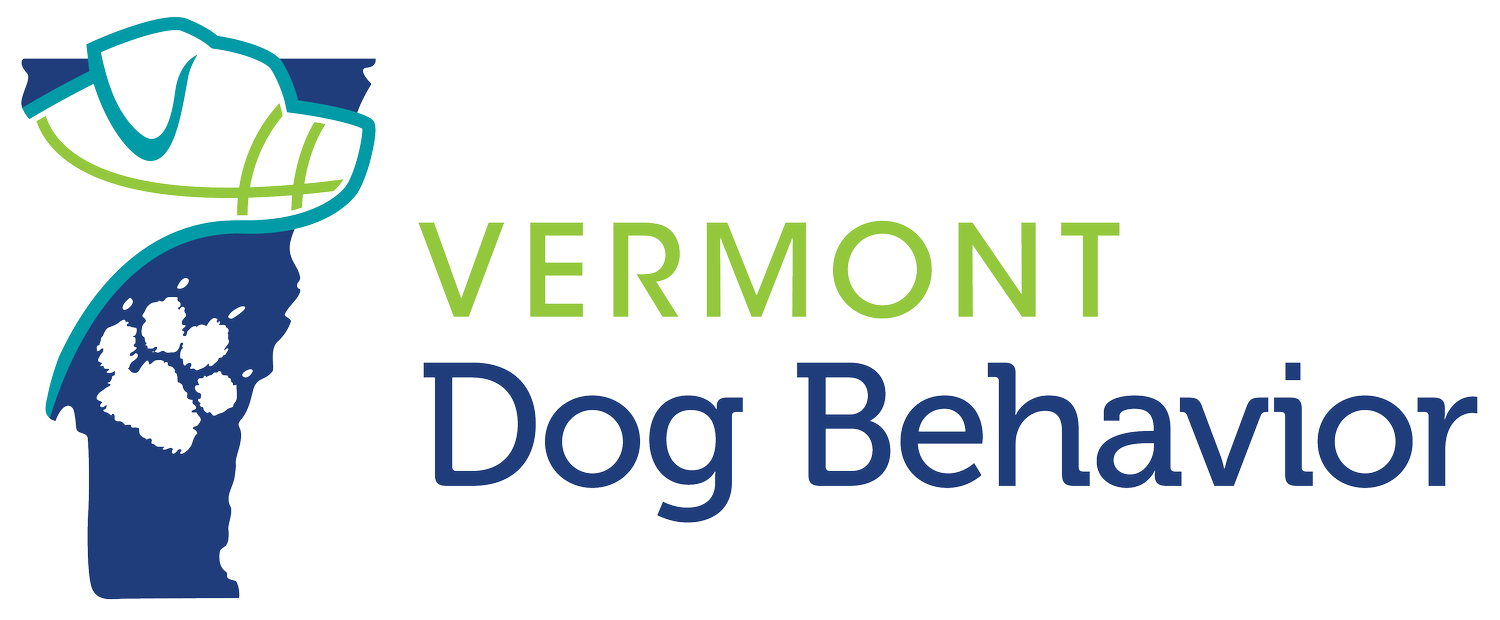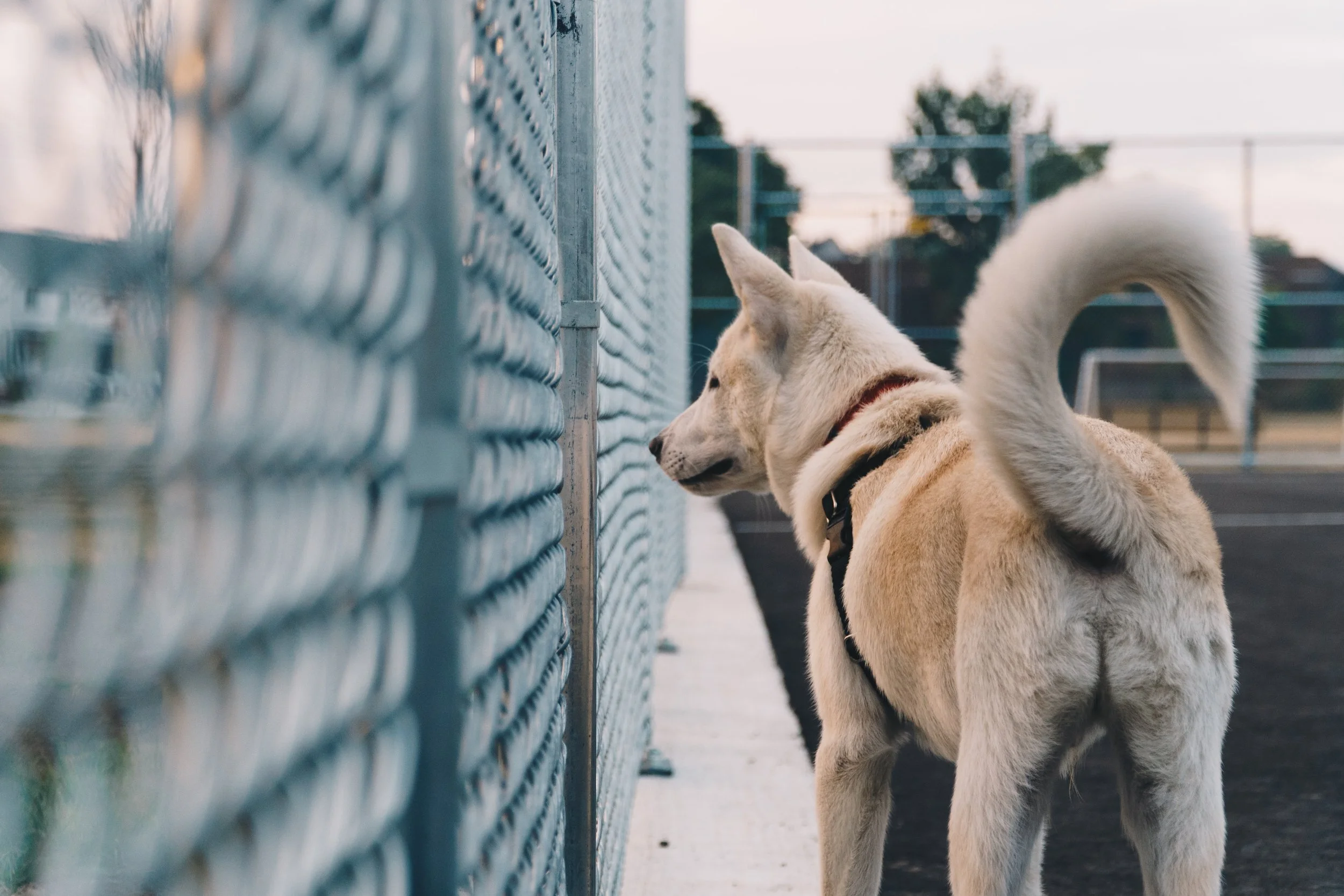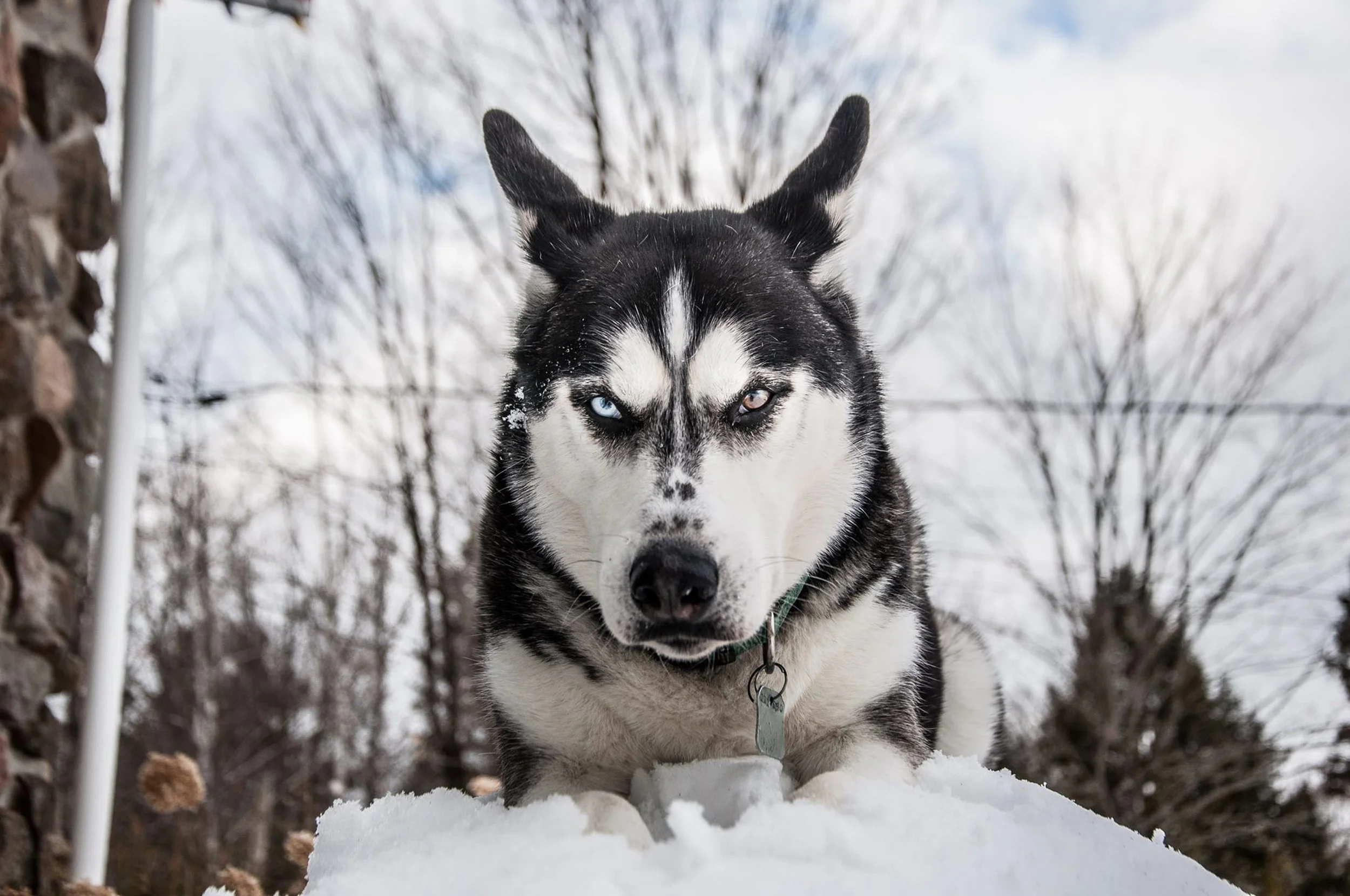Dog Body Language 101
How Dogs Speak without Words
People tend to think that dog body language is straightforward. If your dog is wagging their tail, they’re happy; if they’re yawning, they’re tired; if their hair is standing on end, they’re angry… right? Wrong. We often don’t understand what our dogs are telling us because we ascribe human meanings to dogs’ behavior. In reality, dogs and humans communicate in really different ways. It’s almost like we’re a different species!
Read on to get the scoop on dog body language from the experts at Vermont Dog Behavior. We’re gonna talk about how dogs and humans differ, at-a-glance dog body language, aspects of dog body language that require you to take a closer look, and how to begin putting the dog-body-language puzzle together.
Dogs vs. Humans
Dogs are members of the canid taxonomic family, where it’s polite to greet others in an indirect way. Only the most confident dogs approach quickly and directly, whereas the politest dogs use more of a circular greeting, keeping their movements slow and calculated.
We humans, on the other hand, are primates. Imagine how rude we seem with our head-on approaches, making direct eye contact as we extend our limbs in our dog’s faces to touch, hug, and kiss them. In dog body language, this kind of approach from an unfamiliar individual is threatening.
Even so, the bond between humans and dogs is extremely strong. In fact, there is evidence that suggests that the human-dog relationship is similar to the attachment between infants and their primary caregivers – really lends some validity to the term “dog mom.” Human parents manage to understand the unintelligible babble of baby talk; doesn’t your dog deserve the same courtesy? Learning to speak your dog’s body language can help to strengthen your bond and allow you to advocate for your dog in unfamiliar settings.
Dog Body Language at a Glance
When reading dog body language, body shape is often the first thing we – and other dogs – see at a distance. The at-a-glance perception of a dog’s body language can communicate a lot; dogs who are feeling confident, alert, or threatened will increase their overall body size, and dogs who are feeling stress or are trying to avoid conflict will decrease their body size. In general, dogs who have loose and fluid body movements are likely feeling relaxed and may be open to being approached, whereas dogs with tense, stiff, or cowering bodies are likely feeling weary.
Piloerection, tail carriage, and the direction a dog’s body is shifted are important at-a-glance aspects of dog body language to look out for.
Body Shift
The direction that a dog shifts their body can tell you a lot about how they’re feeling. A dog could be giving clear aggression signals – growling and showing teeth, for instance – but have their body shifted backwards. This signals that they’re on the defense and don’t want to attack if they don’t have to. Another dog showing the same aggressive signals with a forward-shifted body is telling you that they’re confident and willing to follow through on their threat.
Piloerection
Piloerection is the fancy word for when your dog’s fur stands on end – AKA “raised hackles.” This can happen for a number of reasons, ranging from excitement to aggression. In the absence of other bodily cues, piloerection means that a dog is emotionally aroused by something. Reading the up-close details of your dog’s body language, discussed below, can help to clarify which emotions are being aroused.
The Tail
Contrary to popular belief, tail wagging does not simply mean “happy.” The movement of your dog’s tail signals their level of emotional arousal, and tail position can tell you what emotions they’re likely feeling.
Therefore, a steadily wagging tail at a neutral height is your dog’s baseline. If they’re aroused by positive stimuli, like seeing their favorite human, their tail might begin to wag quicker, maybe even creating a circular motion. If your dog becomes aroused by ambiguous stimuli, like a novel sound, they might hold their tail high. As long as their tail is not stiff, is wagging at a steady frequency, and there are no aggressive signals present in the rest of the body, this likely just means that they are curious about something.
On the other hand, a tail that is held high and is wagging stiffly and quickly could mean that your dog feels threatened or stressed. Especially when coupled with other aggressive dog-body-language signals, like the agonistic pucker discussed below, this might be a signal to give your dog some space. On the flip side, a tail that is held low or tucked between the legs is a sure sign of a dog who feels anxious, afraid, and who is trying to make themselves appear smaller.
Dog Body Language Up Close
In her book The Other End of the Leash: Why We Do What We Do Around Dogs, Patricia B. McConnell, Ph.D., discusses the “hierarchy of body parts” to look out for when assessing the body language of a new dog. First, she looks at the dog’s overall body language to get a sense of the dog’s arousal level, then she uses the more minute details – like eye shape and ear movements – to clarify the reasons behind a dog’s arousal levels.
The Face
You can look at a dog’s face to clarify the cues in their body composition.
Relaxed Signals
A dog who is relaxed will have “soft eyes,” which are squinty and half closed. In addition to soft eyes, they’ll have a relaxed, slightly opened mouth. If they’re really relaxed and happy, a dog might even have the corners of their mouth – also known as the commissures – turned up and their tongue lolling out. Their ears will be in a neutral position, sitting high on their head but not pushed forward.
Arousal Signals
An aroused dog is feeling a heightened level of some emotion. Arousal is usually due to stimuli, either positive, negative, or ambivalent.
The physical cues in a dog’s body language are largely dependent on the stimulus they’re experiencing. Regardless of the type of stimuli, dilated pupils and visible sclera – the technical term for the whites of the eyes – indicate arousal. When you see these cues, keep an eye on the rest of your dog’s body language to determine the type of arousal they’re feeling.
If the stimulus is positive, a dog’s mouth might take on the same shape as that of a relaxed dog. On the other hand, if the arousal is caused by more ambiguous or negative stimuli, your dog’s mouth might start to show some of the anxious or aggressive signals discussed below.
A dog’s ears have the ability to move to several different positions depending on their arousal state. In general, a dog who has their ears up and slightly forward is often feeling curious or interested, whether by a novel sight or a strange sound. In the absence of other cues, this position can be read as “at attention.” Subsequent ear movements and other dog-body-language cues can help to clarify which emotions are being aroused.
Anxious Signals
As with arousal, the sclera is important in determining anxiety levels in dogs. A dog who is anxious might display a half-moon or whale eye, in which part or all of the sclera is visible around the cornea. If you see these signals in combination with calming signals like lip licking, yawning, or panting, there’s a good chance your dog is feeling anxious.
In addition to the presence of sclera and calming signals, pushed back ears are also a common sign of anxiety in dog body language. The degree to which the ears are pushed back can give insight into a dog’s anxiety level. Ears that are only slightly back signify an attempt to appease or make nice; “seal ears,” where the ears are pushed flat against the head, signify extreme fear; and “airplane ears,” where the ears are splayed out sideways, indicate conflicting emotions.
Commissures
When distinguishing between anxious and aggressive signals, the commissures are very important. Dogs pull their commissures back, in a gesture nicknamed the defensive grin, to communicate stress. The further back the commissures are pulled, the more intense the dog’s fear.
Aggressive Signals
Though aggression can feel concerning, it’s important to remember that aggressive dog body language does not signify a “bad dog.” Dogs are closely related to wolves, with some researchers considering dogs to be the equivalent of a perpetually juvenile wolf. Wolves use aggression to defend themselves and their resources and to establish order within their pack, and the remnants of these instincts still exist in our loveable pups.
Though aggressive cues can seem worrisome, more often than not they serve as a warning – one that should be heeded. If you notice your dog displaying aggressive body language, it’s important to assess what is driving the behavior and to remove any threatening stimuli.
As with an anxious dog, aggressive dogs may display the whale eye. However, instead of displaying calming signals, an aggressive dog will maintain direct eye contact with the source of their frustrations. Their eyes will also take on a “hard” quality, in which the brow is pushed forward and the pupils are dilated. These signals, in combination with ears that are pushed up and forward, are a sure sign that a dog is feeling threatened.
An aggressive dog will also have a tightly closed and tense mouth. If they’re feeling really threatened, they may have a wrinkled muzzle with teeth showing. As a rule of thumb, the more teeth and gums showing, the more willing a dog is to follow through on their threat.
Commissures
The “agonistic pucker,” in which the commissures are pushed forward, indicates a dog that is prepared to confidently act on their threat. Where the defensive grin signals fear, the agonistic pucker correlates to status-seeking dogs, and the degree to which the mouth is open indicates the level of threat.
Calming Signals
Turid Regaas, a Norwegian dog trainer, calls the act of looking away a “calming signal” in dogs. Calming signals are behaviors that dogs use to calm themselves or other individuals in tense situations.
Yawning
Physiologically, yawning serves the same purpose for dogs and for humans: it relaxes the throat muscles, opens the airways, and supplies more oxygen to the brain. Humans do it when we’re tired or bored, but yawning actually serves an important communicative function for dogs.
Dogs yawn when they’re stressed or are trying to avert conflict. In the face of potentially aggressive encounters, yawns don’t contain any elements of aggression, so one dog may yawn to tell the other, “Hey, I’m no threat.” So, next time your dog seems stressed or you meet a new dog, try yawning to diffuse the tension.
Look Aways
Because eye contact with unfamiliar dogs signifies threat, the act of looking away can work to actively diffuse a threat. Dogs often turn their heads away from other dogs or humans who are distressing them and, like yawning, this translates to “I’m not a threat.” Humans can consciously use dog body language to our advantage by utilizing look aways. By turning your head – or even cocking your head to the side – in the face of a new dog, you can mimic dog body language to communicate that you aren’t a threat.
Displacement Sniffing
Displacement behaviors are normal activities performed at an abnormal time. We all know that it’s normal for dogs to sniff, but what if your dog is insistently sniffing the ground when you’re trying to engage them in an activity, like learning a new command or meeting a new dog? To the untrained eye, this might look like a dog who is being obstinate, but displacement behaviors are actually a sign that your dog is stressed and trying to calm themselves. Displacement sniffing is really common in the dogs we work with, and other examples of displacement behaviors include: excessive sneezing, itching, grooming, and/or lip licking.
Putting it all Together
That was a lot of information. I’m sure you’re wondering how to begin to put the dog-body-language puzzle together. My advice: start by observing. Pay close attention to your dog’s body language, what you do around your dog, and how your dog responds. The information shared in this article is meant merely to serve as a guideline, and it’s important to consider context and the individual personality of your pup.
According to Patricia McConnell, the majority of the work of a dog trainer is training humans to make more sense to their dogs. There is no quick and easy way to do this, but understanding dog body language is an important first step.
If you’d like some company in your mission to deepen your relationship with your pup, or if you’re struggling with behavioral issues that this article alone can’t solve, consider reaching out to Emily Lewis and Laurie Lawless. As certified dog behavior consultants with more than 30 years of experience between them, Laurie and Emily have the tools to help with any behavior struggles you might be facing. Check out the Vermont Dog Behavior website to learn more about Laurie and Emily, tap into the resources in our learning center, or request a consultation.







